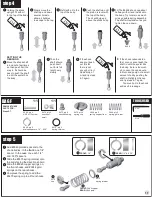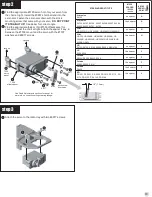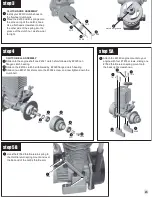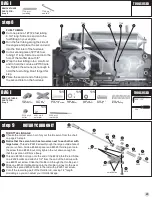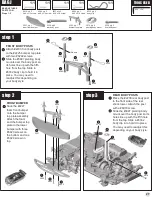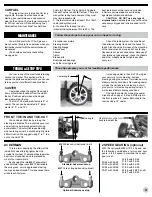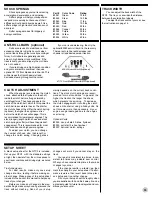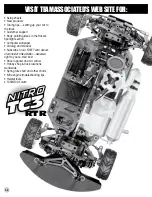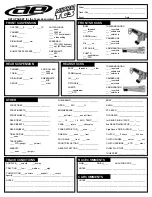
TUNING & SETUP TIPS
These tips prepare your car for maximum performance
CAR FUEL
The proper fuel is very important for long
engine life. Improper fuel can cause hard
starting, poor performance, and excessive
wear on the engine. The fuels we recommend
for R/C car use are: ODonnell Racing Fuel,
Duratrax Red Alert fuel, Blue Thunder Race
Formula, FSR fuel, Trinity, Byrons Originals,
Traxxas Top fuel, and Wild Cat fuel. There are
many other racing fuels; however, they must
meet two requirements:
1.
The fuel must contain at least 18% of both
castor and synthetic oils.
2.
You should try to keep the nitro
(nitromenthane) between 10% to 20%. The
best fuels also contain rust and corrosion
inhibitors, anti wear agents, anti foaming
agents and lubrication additives.
CAUTION: DO NOT use any type of
airplane fuels.
Airplane fuels may not have the
necessary oil types and ratios needed for R/C
cars.
MAINTENANCE
Follow these steps to keep your car in shape for racing
You will find your Nitro TC3 will give you
many hours of trouble-free operation when you
familiarize yourself with these maintenance
procedures.
You should periodically check all the
moving parts:
Front and rear a-arms
Steering blocks
Steering linkage
Servo saver
Shocks
Clutch
Brake parts
Bushings and bearings
and other moving areas.
Check the radio system, the condition of
the batteries, the fuel tank, and the hoses for
leaks. Also check the firmness of the mounting
of the receiver and servos, and check for any
frayed wires or loose connections. Because of
the vibration of gas engines, check the chassis
and other critical screws for tightness after
every run.
Your car is one of the most tunable touring
cars on the market. This section will try to
explain the parts and adjustments you can use
to tune your car for different track conditions.
CASTER
Caster describes the angle of the kingpin
from vertical when looked at from the side of
the car. Positive caster means the kingpin
leans rearward at the top.
The Nitro TC3 standard kit setup is 9° of
caster. The car can be adjusted in 3° incre-
ments (6°, 9°, and 12°).
Increasing caster in the nitro TC3 will give
your car more turn-in steering, but less
steering exiting the corners. It will also be more
stable in bumpy conditions. Decreasing caster
will give the car less turn-in steering, but will
give your car more steering exiting corners. It
will be less stable in bumpy conditions.
Change the caster by moving the caster
clips shown on page 15, step 6. Both clips to
the front results in 6° caster. Both clips to the
rear results in 12° caster.
FRONT TOE-IN AND TOE-OUT
You can adjust front toe by turning the
steering turnbuckles. Toe-in will make your car
easier to drive by improving stability during
acceleration. Toe-out will increase steering
when entering corners, but will be slightly more
difficult to drive. We suggest using 0° to 1° toe-
out on the nitro TC3.
ACKERMAN
This is a term describing the effect of the
inside front wheel turning tighter than the
outside front wheel. The standard setup works
best in most conditions and is preferred by
most of our team drivers.
By changing the two #3857 special ball
ends with two longer neck #6270 ball ends to
the swing rack, a more aggressive steering
feeling can be achieved. This is because there
will be less Ackerman.
caster angle
Use this tool on the turn-
buckle to adjust toe
31
#3857 black short ball ends (in kit)
#6270 silver long ball ends (optional)
toe angle
2 SPEED GEARING (optional)
With the optional #2285 NTC3 2 Speed, use
the following combination of pinion and spur
gears in the 2 speed to maintain the correct
gear mesh.
20/24 with 52/48
21/25 with 52/48
22/26 with 52/48
23/27 with 52/48
20/26 with 54/48
21/27 with 54/48
20/24 with 54/50
21/25 with 54/50
22/26 with 54/50 (in kit)
23/27 with 54/50
Optional Ackerman setup
Standard Ackerman setup

